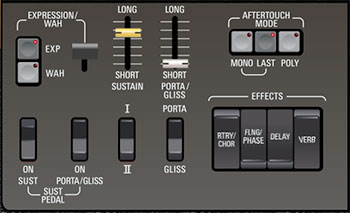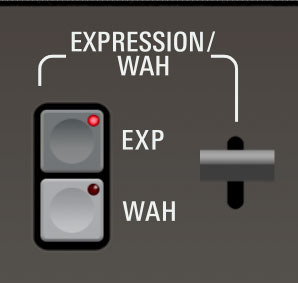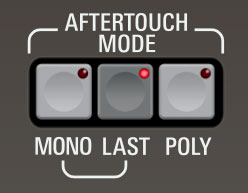
These are regulate additional performance parameters, such as enabling and disabling effects, sustain and expression pedals, and aftertouch behavior.
Expression/Wah

The CS-80 included an expression pedal input that could control overall volume and/or wah. The wah effect was completely independent of the highpass and lowpass filters - like having a guitar wah-wah pedal built into the synth, but by all accounts, it didn't sound so hot, so Mr. Barton dug up a vintage wah schematic and virtually created a sweet-sounding wah for GX-80.
The expression volume and wah effects are global, unlike most other layer-independent GX-80 controls.
Expression/Wah paddle- Controls the amount of volume or wah. The original CS-80 didn't have a panel control for this, but we added one because we wanted to allow users to assign a hardware controller of their choice (i.e. expression pedal, knob, slider, wii-enabled MIDI baseball bat, etc.).
Exp (Expression)- Enables global volume control via the Expression paddle.
Wah - Enables global wah via the Expression paddle.
Exp. and Wah may be used independently or simultaneously.
Sustain Pedal

Sustain switch- This one's a little unusual, but we included it for authenticity. The sustain pedal operates normally when the switch is in the On position - that's probably where you'll want it most of the time. When set to the off (up) position, GX-80 behaves as if the sustain pedal is constantly pressed, so the Sustain slider is always active.
Porta/Gliss switch- When in the On position, portamento or glissando is enabled only when the sustain pedal is down. When set to the off (up) position, portamento or glissando are always on, with the amount set by the adjacent Porta/Gliss slider (set the slider to minimum for no portamento/glissando).
I/II switch- Sets the behavior of incoming sustain pedal control. In mode I, the sustain time is the same and each note fades independently when released; the same as most other synths.
In mode II, the last note or chord played carries the sustain; if multiple notes are released simultaneously all notes fade equally. If a new note is played, all fading notes will instantly silence as the new note takes over. This mode can be very useful when using portamento or glissando.
The I/II switch also affects pitch bend behavior. In Mode I , notes that have been released but are held by the sustain pedal will not be affected by pitch bends. In Mode II all currently sounding notes are equally affected by pitch bend data.
This is the only part of the front panel where "I/II" Roman numerals do not refer to voice ranks - they simply refer to the two different sustain types.
Sustain time slider- This is essentially an additional envelope release time slider (notice that it's yellow, just like the Rank Voice VCA section Release sliders); it works additively with the VCA Release sliders. In other words, when the sustain pedal is depressed, the Sustain slider time setting is added to the VCA section Release slider times. If you're creating a piano-like sound, set the VCA section Release sliders to a low time, and the left-hand Sustain slider to a relatively high time.
Note: There is no way to get an infinite sustain when keys are released as may be possible on other synthesizers. Released notes always decay, similar to on a piano with the sustain pedal down. To keep a note sustaining indefinitely, its key must be held down.
Portamento/Glissando

Porta/Glissando switch- Portamento is a gliding effect where notes slide from one pitch to the next instead of discretely changing pitch - like sliding notes on a trombone. Glissando is similar but the pitch changes in discrete half-steps.
Long/Short slider- Sets the amount of time between notes when using portamento and glissando. The Long/Short slider also acts an on/off switch - portamento and glissando is disabled when the slider is at its lowest position.
The CS-80 employs a very sophisticated digital portamento system. It keeps track of what you're playing and always glides from the last note played to the next note played, just as if you were playing a monophonic instrument, only it does it polyphonically! This behavior is meticulously modeled on the GX-80.
Aftertouch Mode

These regulate how aftertouch affects Touch Response-related parameters at the far right of the Rank Voice Parameters as well as the Sub Osc parameter in the Performance Controls Touch Response section.
As with the original instruments, GX-80 responds to polyphonic aftertouch, but you'll need a controller capable of transmitting it. To be clear, very few synths and MIDI controllers are capable of transmitting poly aftertouch (old Ensoniq keyboards, Kurzweil MIDIBoard, or MIDI MPE controllers from Roli, Keith McMillen, Roger Linn Linnstrument, etc.). Most synths and controllers only transmit what's known as "channel aftertouch"- essentially a single control signal summed or averaged from all keys.
With that said, GX-80 incorporates a unique Last mode, which lets you mimic true poly aftertouch pretty effectively using a MIDI controller that only transmits mono (channel) aftertouch data.
The aftertouch modes operate as follows:
Mono- Increasing pressure to any held key varies mod amount equally for all currently sounding notes.
Last- Increasing pressure to any held key varies mod amount for the most recent note played only.
Poly- Increasing pressure to a held key sends aftertouch control data independently for each key played. As mentioned, poly aftertouch requires a keyboard controller capable of transmitting poly aftertouch, but Last mode is an effective substitute.
Effects Rocker Switches

The Chorus/Rotary, Flange/Phase, Delay, and Reverb rocker switches independently enable the effects at the top left of the panel. Effects may be enabled in any combination. If you're using GX-80 in Dual or Split Layer Mode, effects are completely independent for the upper and lower layers. Please see the Effects section for full information.